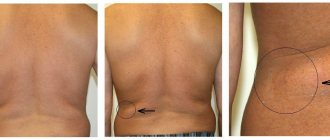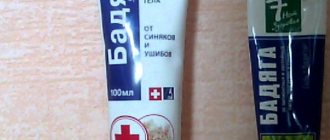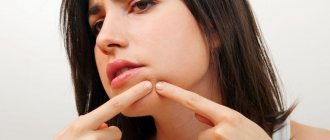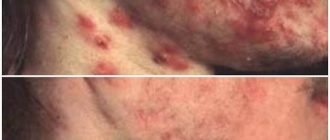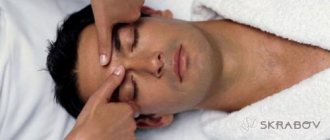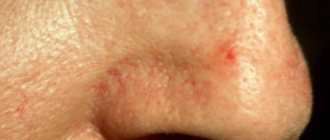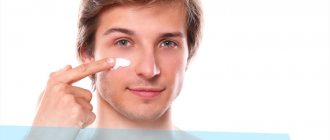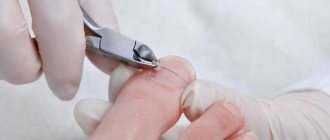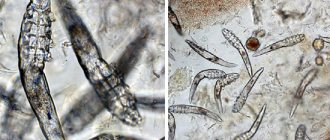Rashes cause great discomfort to their owners, including allergic acne on the face of adults. Sometimes it happens that a person fully complies with hygiene procedures and all the rules, but the rash seems to go away, but over time it appears again.
Allergy is a common cause of this behavior; it occurs as a response of the body’s immune system to any substance. The body perceives them as hostile, as a result of which protective functions are launched to get rid of them in the form of an allergic reaction. If the fact of hypersensitivity to certain substances occurs for the first time, then over time this will increase each time. Therefore, it is recommended to detect the cause of the body’s hypersensitivity in time in order to exclude it.
What causes the allergic reaction?
Substances that cause hypersensitivity: certain foods, household chemicals, medications, certain insect bites, synthetic materials, pollen, personal care products or cosmetics. An allergic reaction of the body on the face in adults does not always appear after contact with a possible allergen. From the beginning of an encounter with an allergic component to a rash on the skin, it can take from several minutes to two days, so it is difficult for a person to establish a relationship. Most often, pimples appear on the skin in the most sensitive places. This could be the face, neck, armpits, bends of the knees or elbows, wrists. To understand what the rashes look like, look at photos of allergic acne on the face.
Appearance of allergic acne and symptoms
At first there is redness and slight swelling, later rashes appear, which can be in the form of simple pimples, or can be watery and very itchy. To prevent a bacterial infection from developing and the pimples from becoming purulent (further complications may arise), scratching them is strictly prohibited. Watery rashes burst over time, forming an area of weeping skin - an ulcer, and later a crust appears. Traces of such acne can remain on the face forever. Also, rashes may not appear; the reaction manifests itself in the form of peeling and also itches a lot.
How to get rid of allergic acne on the face?
Herbal decoctions can help with rashes: calendula, chamomile, string. You can make compresses and apply them to the itchy area, or simply wipe the affected areas with tampons soaked in the broth. If you have not encountered the use of any of these herbs before, then it is not recommended to take risks and experiment; it is better to use already proven plants. If you don’t have medicinal herbs on hand, you can resort to weak brewing of green or black tea. Also blot with a cotton pad and place on the itchy area.
Bay leaves work very well against itching; to do this, pour a glass of boiling water over several bay leaves and keep on low heat for 20 minutes. It can be added to baths, applied as a compress, or wiped over the face. A good skin soothing agent is boric acid. To do this, you need to take half a teaspoon of the product and mix it in one glass of warm water, then blot gauze with the liquid and apply it to the area. Along with the antipruritic effect, the acid also dries out pimples well.
Potato starch or rice flour will help powder the pimple area, since using powder during this period is prohibited. If the allergy has spread further throughout the body, then you can take a warm bath with a glass of oatmeal dissolved in it. Just 10 minutes is enough to relieve symptoms and relieve itching.
When allergic acne appears on the face, you should definitely take the first necessary steps. It is worth gargling and rinsing your nasal passages. We get rid of food residues in the body. If there is an assumption that an allergy on the face has developed after taking certain foods, then vomiting should be induced after drinking plenty of liquid.
Symptoms
Red spots are the first sign of sensitization that appears on the skin of the face. Allergy indicates itself not only with this symptom, but also with a number of other phenomena. Sometimes the face swells. Quite a serious complication is considered to be angioedema, affecting the mucous membranes of the respiratory organs. The patency of the channels deteriorates, as a result, the person suffers from a lack of oxygen. The mucous membranes may become inflamed and red. Often tears are actively produced due to allergies. Possible nasal congestion. Red spots that appear as the first sign of a reaction gradually increase in size and can merge, causing the entire face to change its shade to an unhealthy one. The skin is dry, flaky, rashes and blisters may appear. The affected area is very itchy, sores, cracks, and pimples appear.
Others are scared to imagine what an allergy looks like on the face with all the listed manifestations. In practice, only some of the symptoms are more common, but without adequate treatment the condition worsens and new health problems arise. At the onset of the disease, only a couple of signs are observed, and manifestations on the skin are more often characteristic of children than adults.
Treatment of allergic acne
Treatment of allergic acne on the face must be comprehensive. Not only local substances should be used, but also systemic drugs. Antihistamine ointments will help reduce redness and relieve severe itching. For example, “Gistan”, “Fenistil”, “Psilobalm” and others. Skin-cap is an excellent healing agent, but it can only be used in places where there is no open wound. In more advanced cases, hormonal drugs are prescribed. Antihistamines such as Suprastin, Cetrin, Diazolin and so on are used internally. They stop the formation of new pimples and also reduce the impact of the irritant on the body.
To remove toxins resulting from allergic reactions, it is recommended to take activated carbon, Polyphepan, Enterosgel and other absorbent drugs. Calcium is prescribed in combination with other medications. However, before treating allergic acne on the face, you should consult with an allergist or dermatologist.
Where to begin?
If red spots on the face appear due to allergies, it is necessary to determine which substance provoked the body’s increased susceptibility. To correctly identify the allergen, it is recommended to seek help from an allergist or dermatologist. Areas of hyperemia are only manifestations of a systemic response. Irritation caused by the influence of the allergen will disappear when the dangerous compound disappears from human life, and the functioning of the internal organs stabilizes. After identifying the allergen, the doctor will suggest measures to eliminate it and prescribe a medication program. Antihistamine tablets for systemic action and drugs for local application are prescribed.
Usually, in the case of red spots on the face caused by allergies, creams and ointments with a calming effect are used. Preparations containing panthenol give good results. They stimulate regenerative processes. If the case is severe, hormonal, non-steroidal medications may be prescribed for local application. Sometimes injection administration of medicinal compounds is necessary. The doctor may prescribe various medications in tablet form. This is especially likely if the allergy is complicated in some way.
Traditional methods of treatment
Traditional methods of treatment are not dominant, but they can be an auxiliary method and improve the condition of the skin. Here are some of them: chop two tablespoons of celery root and leave in one glass of water. Divide the resulting mixture into three parts and consume before meals three times a day. You can also drink 1 teaspoon of fresh celery inside 30 minutes before meals.
Dill can improve the condition of allergies: pour one teaspoon of seeds into 300 ml of boiling water, leave, divide into three doses and take.
Soda solution can quickly relieve itching. To do this, prepare the following solution: stir one and a half teaspoons of soda in one glass of warm water, then wipe the rash areas throughout the day.
Compresses made from fermented milk products such as kefir, sour cream, yogurt eliminate itching and relieve swelling in areas of inflammation.
You can mix powdered calamus root with honey in a one to one ratio and take one teaspoon at night.
To quickly cleanse the blood, it is recommended to take an infusion of dead nettle flowers. To do this, take two tablespoons of the herb, pour 2 cups of boiling water and leave in a thermos. Then take the solution half a glass up to five times a day.
Skin tests to determine allergens
Small incisions are made on the inside of the forearm, into which allergens are then injected. If the body has an increased sensitivity to the substance, then the reaction manifests itself within thirty minutes. Manifestation occurs in the form of redness or urticaria. All incisions are numbered with markers to determine the substance to which the body is highly sensitive. To establish the level of allergens, blood is taken, then a group of allergens is identified and sensitivity to the components is determined. This event will prevent unwanted contact with allergens.
Technical features
Studying why red spots on the face appear as a result of allergies, scientists found that there are a lot of allergens, but the sensitization response itself is formed according to the same pattern from case to case. The human body has specific cellular structures that collect data about foreign proteins and proteins inherent in the body. If a foreign cell penetrates inside, the protective function of the immune system is activated, aimed at eliminating a potentially dangerous compound. There are many known reasons why the immune system cannot cope with this function. Sometimes there are too many aggressive components, the immune system can weaken, and there is an additional depressing influence from dangerous environmental factors. As a result, the allergen remains in the body for a long time, causing a specific hypersensitivity reaction.
Rashes in children
The appearance of allergic acne on the face of children is quite common, especially among children from 1 to 5 years old, this is due to their special sensitivity to any environmental irritants. The causes of rashes in children are very different, let's name some reasons: plant pollen, medications, a newly introduced product in the child's diet, ordinary dust, animal hair, insect bites, seasonal changes. Children with weakened immune systems are most susceptible to allergic reactions. Small pimples on a child’s face can be a signal of either a dangerous or completely harmless disease. Some rashes require immediate and long-term treatment, while others occur on their own without leaving a trace. Therefore, the appearance of any changes in the skin should be taken into account and consult a doctor to determine the cause.
Causes of allergies
If your cheeks are burning, it is possible that you have an allergy. Its occurrence can be associated with a variety of reasons. A predisposition to it usually begins in childhood, so if an allergy appears on the cheeks of a baby, this should be the basis for immediately contacting an allergist. If you treat a child in time, when he gets older, he will not feel any discomfort, since with age the body will learn to actively resist the allergen present in its body.
As for the immediate causes of an allergic reaction on the face, there are many of them. They can be combined with each other, as a result of which the allergy on the child’s cheeks may not go away for quite a long time. Adults usually tolerate such a painful condition much easier, since their immunity has already learned to fight the harmful effects of allergens.
So, the causes of painful allergic manifestations on the face most often are the following circumstances:
- poor quality food products;
- some types of drugs and chemicals;
- some types of plants;
- pet hair and excretions;
- dust and dirt;
- cosmetical tools;
- influence of ultraviolet radiation.
Important! Allergies on the cheeks usually appear within 2-3 days after direct contact of the allergen with the skin occurs.
Particular attention should be paid to children, since allergies on the cheeks of a newborn can later develop into a fairly serious chronic disease. For example, as a result of negative effects, he may develop bronchial asthma and other pulmonary diseases.
In addition, cheek allergies in infants may be a sign that they have a hereditary predisposition to it. In this case, it is necessary to take preventive measures from the very first days of a little person’s life to ensure that the disease does not develop into a chronic stage. It is mandatory to carry out blood tests on the child to identify specific allergens.
There can be a large number of them - up to 30. If you identify the most dangerous and active ones, it will be possible to take measures to limit the child from future contact with them.
Consequences
Allergic acne on the face can appear in conjunction with several symptoms, or can form without other pathologies. At the initial stages of the disease, only pimples appear, which over time can open, forming cracks that contribute to the development of eczema. Prolonged allergies have a bad effect on a person’s appearance. Therefore, if there are systematic signs of an allergic reaction, it is necessary to exclude the influence of external irritants and contact an allergist to undergo the necessary course of therapy.
Allergy to eye shadow
Girls love when people pay attention to them. This is no secret to anyone. All sorts of tricks are used for this. One of them is bright makeup, which can highlight the natural beauty of the eyes. However, what should a girl do if she is allergic?
First of all, you need to pay attention to the composition of the shadows. You don't have to be a chemist to guess that eye shadows basically contain dyes. If the shadows are liquid, manufacturers use oils of plant and animal origin.
Allergists recommend avoiding the use of products containing the following substances:
- Tocopherol acetate: May cause burning and irritation around the eyes.
- Aluminum powder: found in eye shadows as a coloring component; negatively affects the nervous system and inhibits the reproductive functions of the body.
- Titanium dioxide: also used as a paint; causes irritation of the mucous membrane of the eyes and nose, and can accumulate in the lungs.
- Propylparaben: a preservative that affects the human endocrine system.
